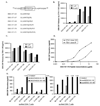Generation of NY-ESO-1-specific CD4+ and CD8+ T cells by a single peptide with dual MHC class I and class II specificities: a new strategy for vaccine design
- PMID: 12097265
- PMCID: PMC2562286
Generation of NY-ESO-1-specific CD4+ and CD8+ T cells by a single peptide with dual MHC class I and class II specificities: a new strategy for vaccine design
Abstract
The existence of overlapping CD8+ and CD4+ T-cell epitopes within certain tumor antigens provides an opportunity to test the hypothesis that relatively short peptides could be used to generate both CD8+ and CD4+ T cells against tumor. In this report, T-cell responses to a fragment of the tumor antigen NY-ESO-1 that contained an HLA-DP4-restricted helper T cell epitope as well as an HLA-A2-restricted cytotoxic T cell epitope were analyzed. One peptide, ESO:157-170 (SLLMWITQCFLPVF) was recognized by both NY-ESO-1-reactive CD8+ and CD4+ T-cell clones. Both CD4+ and CD8+ T cells were efficiently generated from the peripheral blood of multiple melanoma patients after in vitro stimulations using ESO:157-170. Dual-specific peptides containing both cytotoxic T-cell and helper T-cell epitopes may represent an attractive strategy of vaccine design aimed at generating tumor-reactive CD4+ and CD8+ T cells.
Figures

References
-
- Rosenberg SA. Progress in human tumour immunology and immunotherapy. Nature (Lond.) 2001;411:380–384. - PubMed
-
- Rosenberg SA, Zhai Y, Yang JC, Schwartzentruber DJ, Hwu P, Marincola FM, Topalian SL, Restifo NP, Seipp CA, Einhorn JH, Roberts B, White DE. Immunizing patients with metastatic melanoma using recombinant adenoviruses encoding MART-1 or gp100 melanoma antigens. J. Natl. Cancer Inst. 1998;90:1894–1900. - PMC - PubMed
-
- Marshall JL, Hoyer RJ, Toomey MA, Faraguna K, Chang P, Richmond E, Pedicano JE, Gehan E, Peck RA, Arlen P, Tsang KY, Schlom J. Phase I study in advanced cancer patients of a diversified prime-and-boost vaccination protocol using recombinant vaccinia virus and recombinant nonreplicating avipox virus to elicit anti-carcinoembryonic antigen immune responses. J Clin. Oncol. 2000;18:3964–3973. - PubMed
-
- Nestle FO, Alijagic S, Gilliet M, Sun Y, Grabbe S, Dummer R, Burg G, Schadendorf D. Vaccination of melanoma patients with peptide- or tumor lysate-pulsed dendritic cells. Nat. Med. 1998;4:328–332. - PubMed
-
- Rosenberg SA, Yang JC, Schwartzentruber DJ, Hwu P, Marincola FM, Topalian SL, Restifo NP, Dudley ME, Schwarz SL, Spiess PJ, Wunderlich JR, Parkhurst MR, Kawakami Y, Seipp CA, Einhorn JH, White DE. Immunologic and therapeutic evaluation of a synthetic peptide vaccine for the treatment of patients with metastatic melanoma. Nat. Med. 1998;4:321–327. - PMC - PubMed
MeSH terms
Substances
Grants and funding
LinkOut - more resources
Full Text Sources
Other Literature Sources
Molecular Biology Databases
Research Materials
